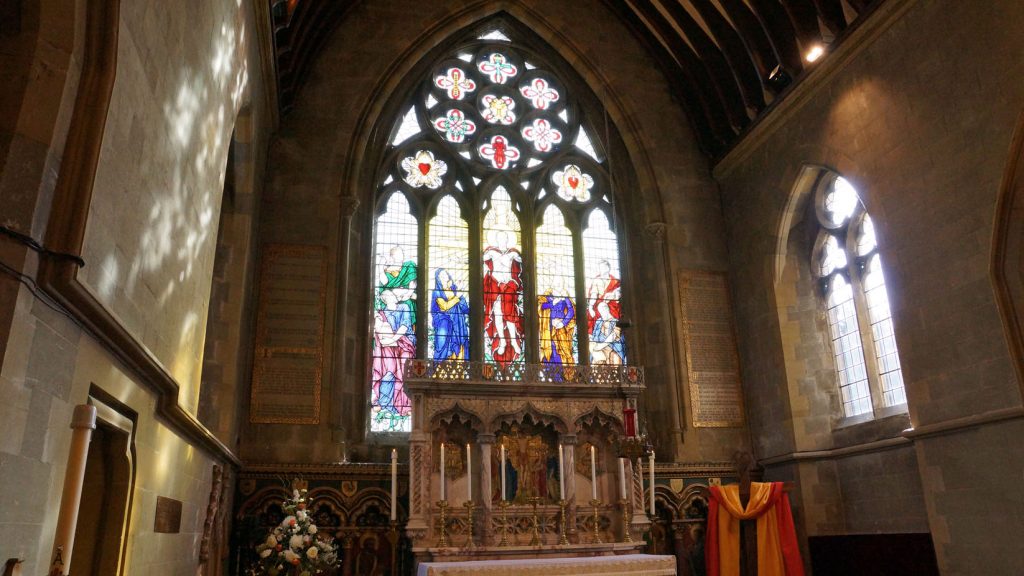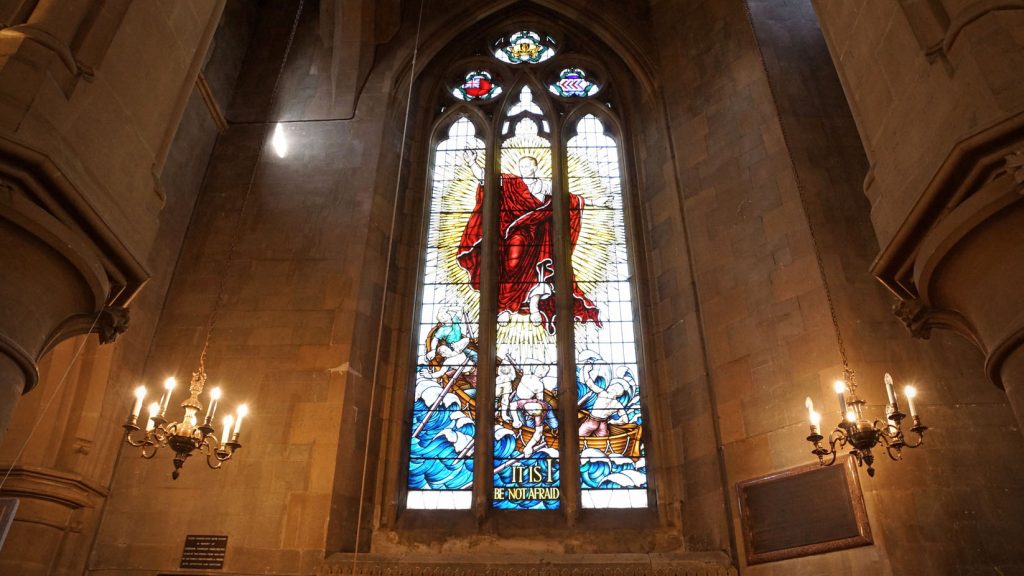2006 marked the 150th Anniversary of the consecration of the new church building of St John the Evangelist by Archbishop Bird Sumner, The Archbishop of Canterbury.
In July 1836, a small chapel, dedicated to St John the Evangelist was opened in Shirley, built to accommodate upwards of 200 people. As the neighbourhood grew the Chapel proved to be too small and Lord Ashburton gave a plot of land adjoining the chapel yard in order to provide a site for a new larger place of worship. Starting with two subscriptions of £1,000 an appeal was raised and in the autumn of 1854 building of the new church was commenced. The work was undertaken by Mr W. Harris of Croydon, from the designs of Sir Gilbert Scott at a cost of upwards of £5,000. It was intended to accommodate 350 persons but by a little rearrangement, 450 were seated at the consecration.
The design is early Gothic, surmounted by a pretty spire; the exterior is composed of flints, with Tunbridge sand-stone and Kentish rag-stone dressings. The principal entrance is through a porch facing the road via a lych gate and path.
The interior design has a beautiful simplicity with a nave and two side aisles, which are divided by two rows of arches, supporting an open roof of varnished pine. The interior is composed of Bath and Tunbridge sand-stone, dressed with Godstone fire-stone; the sand-stone being placed in alternate pieces from the spring of every arch, which from its difference of colour, has a very pleasing effect.
The floor (now largely carpeted), is composed of tessellated pavement, that visible in the chancel and at the west end being of Cornish encaustic tiles.
The original stained glass windows, by Oliphant, were lost to flying bomb damage during WWII and the East window was replaced in 1949 by an image of the resurrected Christ by Hugh Easton. (see article below)
The current pulpit was donated by the Home Guard in 1950 and a new west window was installed in 1951.
In 1956 there were Centenary celebrations and a Memorial Chapel of St George was added. This was dedicated by Archbishop Geoffery Fisher.
In 1986 Shirley became part of Southwark Diocese instead of Canterbury.
A new two manual pipe “Frobenius” organ was installed in 1992
In 2000 reordering took place opening up the chancel, creating an upper vestry and improving the storage space at the west end of church.
Floodlighting to the exterior was installed in 2004
The Church Windows

The East Window (shown right) was dedicated 1st May 1949 by Rev JSF Harris, (nephew of Miss Parker who gave the window in memory of her parents).

The West Window was given in memory of a young merchant seaman torpedoed in the Battle of The Atlantic on the s.s. “Baltisan” of the Strick Line. It depicts a Vision of our Lord to sailors in distress. In the tracery above can be seen the Naval Crown with the flags of the Merchant Navy and Strick Line.
Originally windows were holes in the wall to let light in. Later glass was added to the holes to keep out the wind and the rain. In our homes most windows are placed where we can see out of them and are made with clear glass. In some older buildings such as schools the windows were high so that we would not be distracted by what was happening outside. The same applied to churches, but here the windows carried some of the illustrations that were used to teach the congregation, many of whom could not read, about events in the bible. As more people began to read, the need for illustration became less important and the windows became somewhere to place a memorial to someone who had been a prominent member of the local community.
Large sheets of glass were very expensive so windows were made up of small pieces and where a window did not have an illustration, the window would often be filled with small diamond shaped pieces of glass usually tinted.
After the Victorian windows of St John’s were blown out in 1944 they were replaced temporarily by clear glass but offers to replace the east and west windows were accepted and designs were submitted by Hugh Easton whose work had been acclaimed in several places including Westminster Abbey where his “Battle of Britain” window had recently been installed. The east window depicts the Resurrected Christ with arms outstretched. In the central light; behind Him is the cross on which He was crucified.
Beneath the outstretched hands are the two Marys – Mary the Mother of Jesus and Mary Magdalene (in her hand is the box of alabaster ointment). Both Marys are looking towards Jesus.
In the far left light (next to Mary the Mother of Jesus) and on the far right light, the four Evangelists are depicted, each holding a gospel. On the left St Mark and above him St John. On the right St Matthew, with one foot on a bag of money which denotes his former profession, and behind him St Luke.
In the tracery above the figures (illustrated above) are to be seen, on the left, the five wounds of Christ and on the right the symbol of Mary the Mother of Jesus. “A sword shall pierce your heart also”
Above in the centre are the Chalice and Host, surrounded by the emblems of the Passion. From the left downwards, ladder, sponge and whipping post, the crown of thorns and nails. At the bottom, the tunic, without seam. From the far right downwards the pincers, hammer and spear and the dice.
For those interested in stained glass, Hugh Easton’s “artists mark” can be seen at the extreme right bottom corner. This may help you identify other examples of his work elsewhere.
The Memorial Chapel
When the Memorial Chapel was built it was decided to have one large stained-glass window facing the south aisle, with a smaller one over the Altar, both to be designed by Hugh Easton. The latter depicts St George slaying the Dragon. The Memorial window depicts the Cross of Glory surrounded by the Crown of thorns – Glory through suffering. The Cross stands above the smoke and flames of war with the Altar at the foot of which is draped the Robe of Christ. On the step lie the uniforms of the three Services representing those who gave their lives in the war, the whole symbolising the Lesser sacrifice of men taken up into the One great sacrifice of our Lord upon the Cross.



